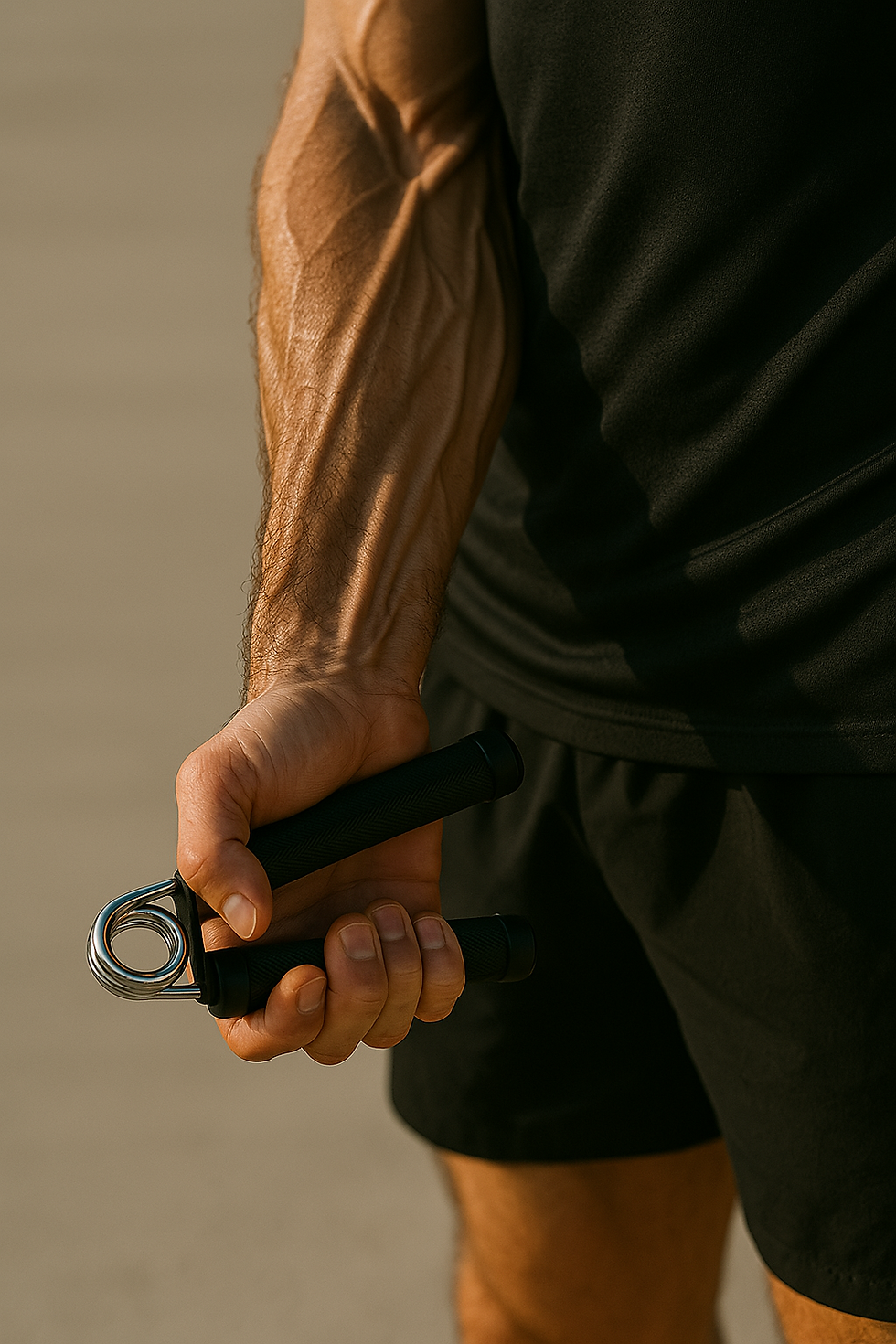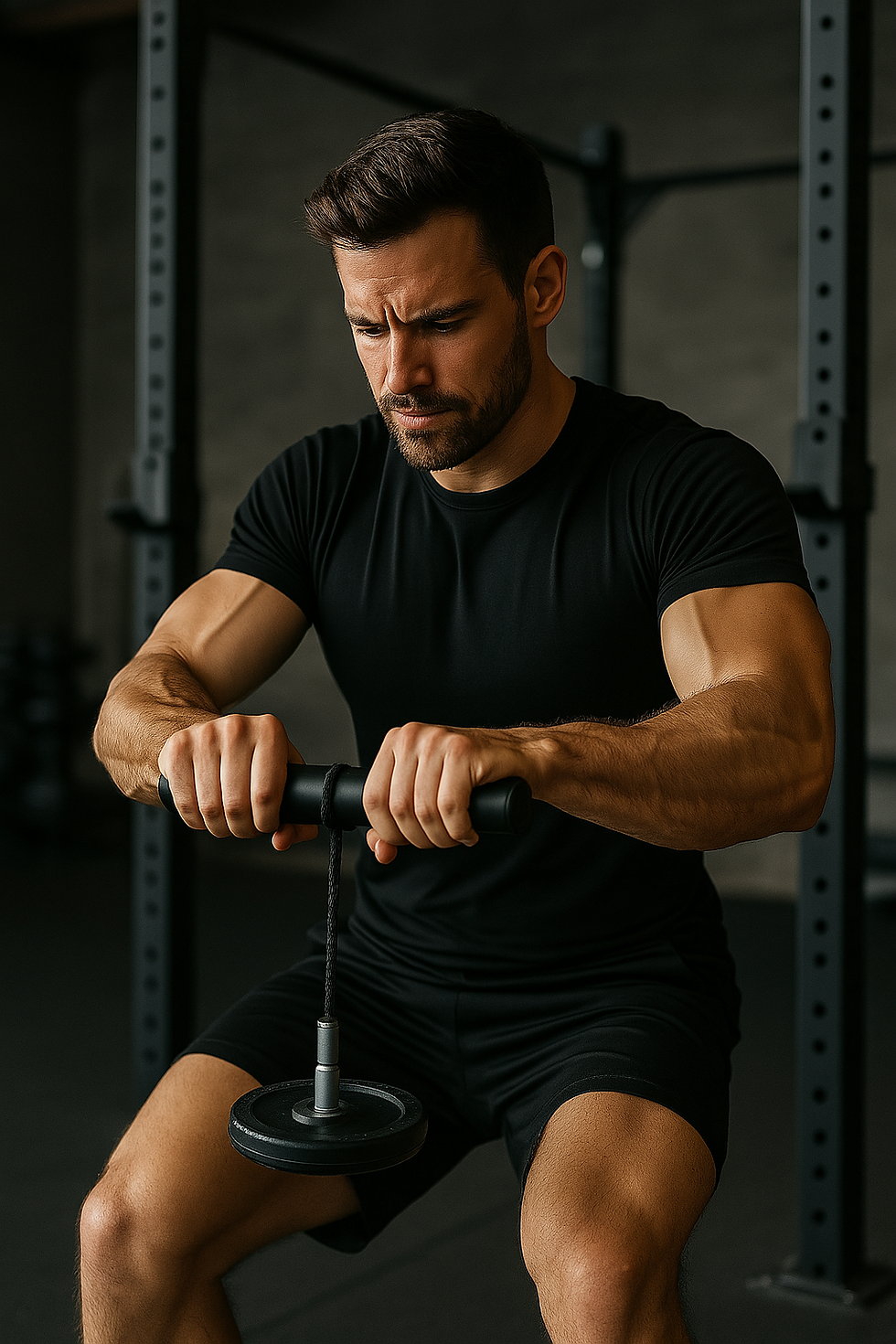Grip Strength: Power Starts in Your Palms
- FitnessFirstAcademy

- Apr 5
- 4 min read

When most people think about getting stronger, they picture bench presses, deadlifts, or squats. Rarely do they think about the simplest, most primal form of strength: grip strength. Yet, this overlooked component of fitness has a massive influence on total-body performance, athletic potential, injury prevention, and even longevity.
At Fitness First Academy, we believe in building athletes from the ground up—and that includes your grip. Whether you’re lifting weights, playing sports, or just opening a stubborn jar, grip strength plays a critical role in daily life and performance.
Why Grip Strength Matters More Than You Think
1. The Foundation of Strength
Your grip is the first point of contact with the weight you’re lifting. If your grip gives out before your muscles do, you’re leaving gains on the table. Whether it’s a heavy deadlift, a pull-up, or a farmer’s carry, grip strength directly determines your ability to exert force.
Expert Insight:
Dr. Stuart McGill, renowned spine biomechanist, has repeatedly emphasized the importance of grip strength, especially in relation to core stability and full-body tension. “Strong hands and a stiff core create the athletic linkage required for high performance,” says McGill.
2. Improves Lifts Without Changing the Program
Struggling with plateauing lifts? Weak grip might be the bottleneck. Strengthening your hands, wrists, and forearms can enhance your deadlift, rows, and even push movements by improving overall muscle engagement and neural activation.
3. Boosts Performance in Most Sports
In sports like football, martial arts, baseball, rock climbing, or tennis, grip plays a pivotal role in controlling opponents or equipment. For example, a stronger grip improves wrist control in grappling, and enhances arm swing efficiency in sports involving throwing or swinging.
Note: Grip strength doesn’t play a major role in soccer performance—except for goalkeepers—but it’s still crucial for strength training, injury prevention, and overall resilience.
4. Injury Prevention
A strong grip builds resilience in the wrist, elbow, and shoulder complex. This reduces the risk of overuse injuries, tendonitis, and compensatory strain from poor control during heavy or dynamic movement.
5. A Marker of Longevity
According to research published in The Lancet and BMJ, grip strength has been correlated with decreased all-cause mortality. In simpler terms: the stronger your grip, the longer you’re likely to live.
Best Exercises to Develop Crushing Grip Strength
Here are some of the most effective and proven methods to level up your grip:
1. Farmer’s Carries (Heavy or Long Distance)

Grab a pair of heavy dumbbells or kettlebells and walk. Simple—but brutal.
How to do it:
• Keep your core braced, shoulders down and back.
• Walk 20–40 yards with as heavy a load as possible.
• Optional: Use towels or thick grips to increase the difficulty.
Benefits: Full-body engagement, forearm isometric strength, core stabilization.
2. Barbell Finger Rolls (Barbell Wrist Curls Forward & Reverse)
An old-school bodybuilding favorite, this strengthens the forearms and fingers dynamically.
How to do it:
• Load a barbell lightly and sit on a bench.
• Rest forearms on thighs, palms up or down depending on direction.
• Let the bar roll down your fingers, then curl it back up.
• Do for time (30–60 seconds) or reps (12–15).
3. Plate Pinches
Hold two smooth-sided plates together (like 2 x 10s or 2 x 25s) and pinch them between your fingers.
How to do it:
• Keep fingers straight, shoulders relaxed.
• Hold for time (start with 20–30 seconds).
• Progress by increasing weight or adding movement.
4. Dead Hangs (With or Without Towels)

This builds passive grip strength and shoulder stability.
How to do it:
• Hang from a pull-up bar with arms fully extended.
• Aim for 30–60 seconds.
• Progress by using one arm, adding towels, or wearing a weighted vest.
5. Thick Bar or Fat Grip Training
Using thick bars or Fat Gripz for curls, rows, and presses increases hand and forearm activation dramatically.
Why it works: Your nervous system lights up when the load becomes unstable in your hands. This boosts recruitment from elbow to shoulder.
6. Wrist Roller

This old-school tool burns the forearms like nothing else.
How to do it:
• Attach a weight plate to a rope connected to a rod.
• Roll the weight up and down using just your wrists.
• Repeat 2–3 times. High tension, low reps.
7. Grip Crushers / Hand Grippers
High-resistance grippers (like Captain of Crush) are great for building crushing strength.
Programming tip:
• Use low reps (3–5) for max strength
• Use high reps (15–20) for endurance
• Try holds for 10–30 seconds to build crushing power
Programming Tips
• Train grip 2–3 times per week
• Vary intensity: mix max-effort crushing strength with endurance and time-based work
• Cycle through static (holds), dynamic (curls/rolls), and ballistic (throws or rope climbs if available)
• Don’t overdo it—forearms recover slower than other muscles
Grip Strength in Real Life
You don’t need to be a powerlifter to benefit. Stronger grip translates to:
• Carrying groceries in one trip
• Picking up your kids
• Doing yard work without strain
• Holding yourself in yoga or calisthenics
• Feeling more powerful in every movement, every day
Final Thoughts: Train Your Grip, Transform Your Strength
Ignoring grip strength is like building a fortress on a crumbling foundation. Whether you’re chasing aesthetics, performance, or longevity, improving your grip can accelerate progress across the board. At Fitness First Academy, we believe real strength starts where your body connects to the world—your hands.
Start simple. Stay consistent. Build a grip that never quits.
References
1. McGill, Stuart. Back Mechanic. Wabuno Publishers, 2015.
2. Rantanen, Taina, et al. “Midlife Hand Grip Strength as a Predictor of Old Age Disability.” JAMA, vol. 281, no. 6, 1999.
3. Celis-Morales, Carlos, et al. “Grip Strength and Cardiovascular, Respiratory and Cancer Outcomes: UK Biobank Study.” BMJ, 2018.
4. “Grip Strength as a Marker of Mortality.” The Lancet, 2015.
5. Pavel Tsatsouline, Beyond Bodybuilding. Dragon Door Publications, 2005.

About the Author
Alexander Morrow is a NASM Certified Personal Trainer, ACE Certified Personal Trainer, ACE Certified Group Fitness Instructor, NCSF Certified Strength & Conditioning Coach & ACE Fitness Nutrition Specialist with a passion for helping people reach their fitness goals. With a focus on strength training and functional movement, he believe in building a strong, capable body from the inside out. Connect with @FitnessFirstAcademyF1A on Instagram or visit www.FitnessFirstAcademy.com/blog for more training tips and inspiration.
Get Ready to Feel Strong and Powerful



Comments